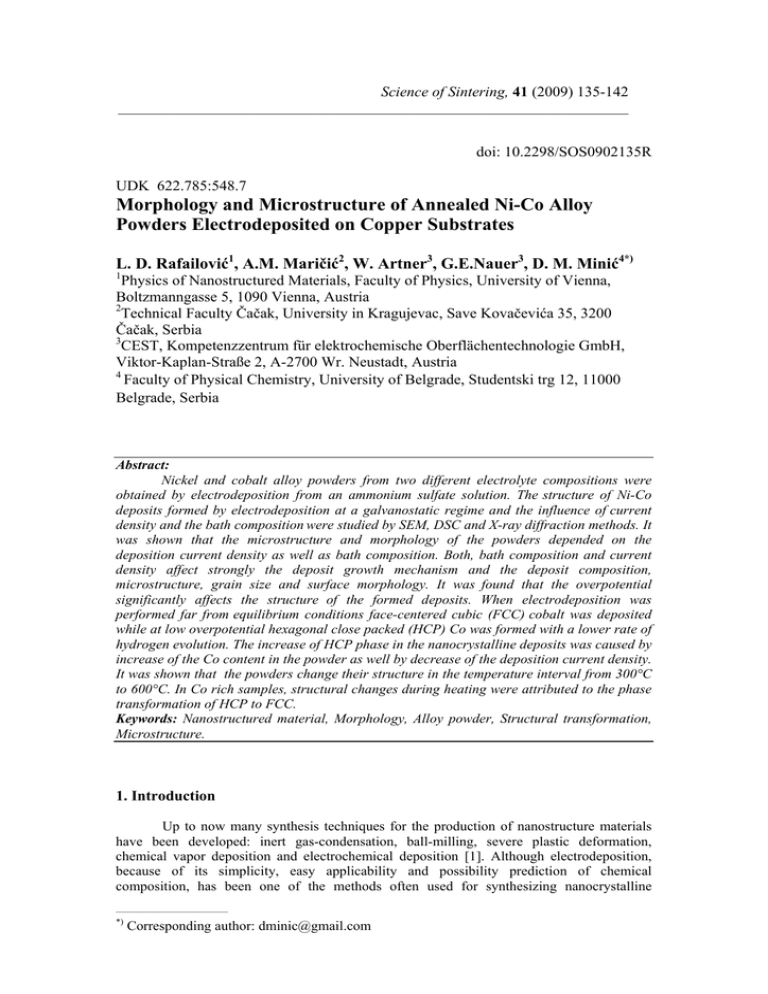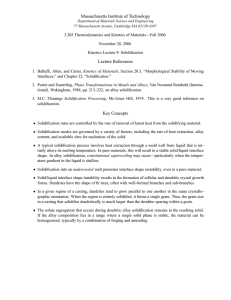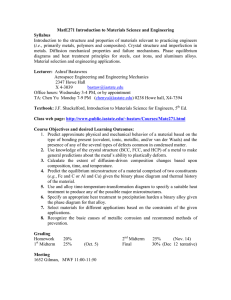Morphology and Microstructure of Annealed Ni
advertisement

Science of Sintering, 41 (2009) 135-142 ________________________________________________________________________ doi: 10.2298/SOS0902135R UDK 622.785:548.7 Morphology and Microstructure of Annealed Ni-Co Alloy Powders Electrodeposited on Copper Substrates L. D. Rafailović1, A.M. Maričić2, W. Artner3, G.E.Nauer3, D. M. Minić4*) 1 Physics of Nanostructured Materials, Faculty of Physics, University of Vienna, Boltzmanngasse 5, 1090 Vienna, Austria 2 Technical Faculty Čačak, University in Kragujevac, Save Kovačevića 35, 3200 Čačak, Serbia 3 CEST, Kompetenzzentrum für elektrochemische Oberflächentechnologie GmbH, Viktor-Kaplan-Straße 2, A-2700 Wr. Neustadt, Austria 4 Faculty of Physical Chemistry, University of Belgrade, Studentski trg 12, 11000 Belgrade, Serbia Abstract: Nickel and cobalt alloy powders from two different electrolyte compositions were obtained by electrodeposition from an ammonium sulfate solution. The structure of Ni-Co deposits formed by electrodeposition at a galvanostatic regime and the influence of current density and the bath composition were studied by SEM, DSC and X-ray diffraction methods. It was shown that the microstructure and morphology of the powders depended on the deposition current density as well as bath composition. Both, bath composition and current density affect strongly the deposit growth mechanism and the deposit composition, microstructure, grain size and surface morphology. It was found that the overpotential significantly affects the structure of the formed deposits. When electrodeposition was performed far from equilibrium conditions face-centered cubic (FCC) cobalt was deposited while at low overpotential hexagonal close packed (HCP) Co was formed with a lower rate of hydrogen evolution. The increase of HCP phase in the nanocrystalline deposits was caused by increase of the Co content in the powder as well by decrease of the deposition current density. It was shown that the powders change their structure in the temperature interval from 300°C to 600°C. In Co rich samples, structural changes during heating were attributed to the phase transformation of HCP to FCC. Keywords: Nanostructured material, Morphology, Alloy powder, Structural transformation, Microstructure. 1. Introduction Up to now many synthesis techniques for the production of nanostructure materials have been developed: inert gas-condensation, ball-milling, severe plastic deformation, chemical vapor deposition and electrochemical deposition [1]. Although electrodeposition, because of its simplicity, easy applicability and possibility prediction of chemical composition, has been one of the methods often used for synthesizing nanocrystalline _____________________________ *) Corresponding author: dminic@gmail.com 136 L.D. Rafailovic et al. /Science of Sintering, 41 (2009) 135-142 ___________________________________________________________________________ materials, properties of nanocrystalline electrodeposits after annealing at different temperatures, especially important for tribological application in nanoscale devices such as micro and nanoelectromechanical systems (MEMS and NEMS) have not been evaluated enough. The knowledge of the thermal stability and structural transformations of these materials is of great interest for two important reasons [2]. First, for nanostructured materials that exhibit excellent magnetic and electric properties the onset of crystallization represents the limit when these properties begin to deteriorate. Second, control of the crystallization process gives us ability to tailor the microstructure that provides desired properties in a nanocrystalline matrix of materials. On the other hand, the ability to predict and control the crystallization process of nanostructured materials is very important for the preparation and preservation of useful microstructures [3]. In the present study the composition, the morphology and microstructure of Ni-Co powders galvanostatically deposited were investigated as well as their thermal stability and structural transformations in the temperature range from ambient temperature to 600oC. 2. Experimental details Deposition of Ni-Co alloys were carried out galvanostatically from ammonium sulfate-chloride solutions, at pH=10, containing different Ni2+/Co2+ concentration ratios; Ni2+/Co2+= 0.25 and Ni2+/Co2+= 4 [total concentration NiSO4+CoSO4=0.12 moldm-3; 0.5moldm-3 NH4Cl and 3.5 moldm-3 NH4OH] at pH=10 in an glass cell with a volume of 1.0 dm3 without stirring, thermostatically controlled at a temperature of 298±1.0K. Cu platelets placed in the center of the cell with a 1.0 cm2 surface area and 0.2 cm thickness were used as working electrodes. A Ti-plate covered with RuO2/TiO2 (10 cm2 geometric area), placed close and parallel to the Cu-plate, was used as an anode. Electrodeposition of the powder was performed with a constant current regime in the range of 40.0-450.0 mAcm-2. For the surface morphology characterisation the XL 30 ESEM-FEG (environmental scanning electron microscope with field emission gun, FEI Company, Netherlands) was used. For 3D analysis of the specimen surface, MeX software from Alicona (A) was applied, enabling profile- and roughness measurements and area analysis directly from the digital images. An alloy composition analysis was performed by ESEM using EDX software Genesis (USA). X-ray powder diffraction (XRD) analysis was carried out using a MRD diffractometer (Philips, NL) with CuKα radiation (40kV/30 mA). The step scan mode was 0.03º in 2θ, hold time 1.15 s step. The angular 2θ range investigated was 30-110 deg. Structural transformations of the alloy powders were determined after annealing at selected temperatures for 30 minutes in an argon atmosphere. DSC measurements were performed using a DSC-204 C (Netzsch, D) in the temperature range of 25 to 600°C in argon atmosphere with a heating rate of 20 Kmin-1. Results and discussion a) Morphology of nanocrystalline deposits obtained from different bath compositions For all current densities in the range between 65 and 400 mAcm-2 deposits with the size of agglomerates varying from 5 µm to about 50 µm were obtained. Fig. 1 presents SEM micrographs (micrographs a-b) of the alloys, electrodeposited out of electrolytes with different Ni2+/Co2+ concentration ratios (4, and 0.25, respectively) at the current density of j = 65 mAcm-2, as well as the corresponding 3D SEM micrographs (micrographs i-ii). The deposit with the highest content of Ni2+ in the electrolyte (micrographs 1 a and 1 i) exhibits a L.D. Rafailovic et al./Science of Sintering, 41 (2009) 135-142 137 ___________________________________________________________________________ cauliflower-like structure, consisting of small particles with an average radii < 500nm, surrounded with diffusion zones where the deposition took place in a spherically symmetrical way. The particles deposited out of an electrolyte with the highest content of [Co2+] (micrographs 1 b and 1 ii) shows the platelet structure, with preferred orientation and a size of the platelets in the µm range. i) ii) Fig. 1 Left hand side: SEM micrograph of Ni-Co deposits galvanostatically prepared from of electrolyte with different Ni2+/Co2+ ratio: a) 4 and b) 0.25, at a current density of j=65 mAcm-2. Right hand side (i-ii): corresponding 3D SEM reconstructions of the surface of the Ni-Co deposits. As can be seen from micrographs in Fig. 1, the surface morphology of the deposits is determined by the nature of the electrochemically active ions or complexes and kinetics of the electro-crystallization processes. Overpotentials of 1.3 V are needed for the deposition of very disperse powder [4]. b. Chemical composition of nanocrystalline deposits The chemical compositions of the galvanostatically deposited alloys were determined for alloy samples of surfaces of 10µm2 with an error of ±2%, as summarized in Tab. I. L.D. Rafailovic et al. /Science of Sintering, 41 (2009) 135-142 138 ___________________________________________________________________________ Tab. I. Chemical composition of the alloys galvanostatically deposited from electrolytes with different ratios of Ni2+/Co2+, at current density j=65 mAcm-2 Ratio of Ni2+/Co2+ in electrolyte 4:1 j=65 mAcm-2 Alloy 1 1:4 j=65 mAcm-2 Alloy 2 Content in alloy Ni Co At% 80.0 20.0 At% 5.5 94.5 According to the EDX results, the increase in current density leads to an increase of the Ni content in the deposits. At current density of j = 65 mAcm-2, the content of cobalt in the alloys is higher than in the electrolyte, as a consequence of the lower over potential for the Co2+ reduction compared to one for Ni2+. Increasing the current density shifts the ratio of nickel and cobalt in the alloys closer to the value of concentration of the corresponding ions in electrolyte. The phenomenon of anomalous Co-deposition (characteristic for the electrodeposition of iron group metals) is very pronounced in the production of compact deposits. However in the case of powder deposition, anomalous Co-deposition is much less pronounced, so that the composition of the alloy powder deposited at high current density is almost similar to the concentration of the metal ions in the electrolyte. c. Thermal stability of nanocrystalline deposits The thermal stability of alloys (prepared as powder from of electrolytes with concentration ratios in the bath Ni2+/Co2+ = 4, alloy 1, and Ni2+/Co2+ = 0.25, alloy 2, at j=65mAcm-2 was characterized by DSC analysis (temperature range from room temperature to 600oC) XRD and SEM methods. DSC /(mW/mg) ↓ exo 0.05 Area: -10.37 J/g 0.00 Area: -25.84 J/g -0.05 Peak: 198.4 °C -0.10 Peak: 432.4 °C -0.15 100 150 200 250 300 350 Temperature /°C 400 Fig. 2a Heat flow difference of alloy 1; heating rate 20 Kmin-1 450 500 550 L.D. Rafailovic et al./Science of Sintering, 41 (2009) 135-142 139 ___________________________________________________________________________ DSC /(mW/mg) ↓ exo 0.0 -0.1 Area: -190.6 J/g -0.2 -0.3 -0.4 -0.5 -0.6 -0.7 Peak: 428.5 °C 100 150 200 250 300 350 Temperature /°C 400 450 500 550 Fig. 2b Heat flow difference of alloy 2; heating rate 20 Kmin-1 The first heating run of as-prepared samples shows a significant heat flow in comparison to the second heating run, measured after cooling the sample to ambient temperature; the heating run was repeated to check if the process of transformation is completely finished as well as to obtain a baseline. Subtracting the DSC curve of the second run from the first one gives the heat released, Figs. 2 a and b [5]. The thermal behavior of the powder of alloy 1 (Ni2+/Co2+ =4, j=65mAcm-2) is depicted in DSC curves, Fig. 2a. As in many studies on the thermal stability of nanocrystalline materials Ni-Co alloy powders during heating exhibit also a series of structural transformation and quasi-nucleation growth processes. The heat release associated with structural relaxation in the temperature range 120-300°C was ΔH= -10.3 J/g and for further structural transformations in the temperature range 380-530°C, released heat was ΔH= -25.8 J/g. The thermal behavior of the of Ni-Co powder of alloy 2 (electrolyte ratio Ni2+/Co2+ =0.25, j=65mAcm-2) shown on the DSC curve Fig. 2b characterized by a broad exothermic peak indicates a stepwise process of structural relaxation and transformation of the alloy in the temperature range 300-550oC. A exothermic shoulder in the temperature range 280-300oC can be attributed to the structural relaxation process. During grain growth, as the system moves from the condition of an as-prepared nanocrystalline sample of higher excess free energy to the condition of the annealed sample exhibiting lower excess of free energy, there is an enthalpy release of ΔH= -190.6 J/g, giving a measure of the thermal stability of the sample connected with the phase transformation from HCP to FCC structure. When nanocrystalline deposits are brought to an elevated temperature, the nanometer-sized crystallites in the deposits start to grow in a random, non-uniform way and some of the present nanocrystallites appear as nuclei and preferentially start to grow at the expense of the surrounding nanocrystalline matrix. The as-deposited microstructure of each alloy was characterized further by XRD and SEM methods. For this purpose the samples of alloy 1 were sealed in glass tubes and heated L.D. Rafailovic et al. /Science of Sintering, 41 (2009) 135-142 140 ___________________________________________________________________________ Arbitrary intensity at temperatures of 250, 350 and 550°C for 30 minutes. These temperatures have been chose according to DSC curve. The XRD patterns of the alloy 1 heated up to 550°C (Fig.3) and Rietveld refinement analysis show only grain growth. No reflections related to cobalt or nickel oxides were detectable. 0 T= 550 C S S 0 T= 350 C S 0 311 S 200 220 S 60 as-prepared 80 222 S S 40 S 111 T= 250 C 100 2θ [ ° ] Fig. 3 XRD patterns of alloy 1 as prepared as well as annealed at the different temperatures T=350°C S 220-FCC 222-FCC T=550°C S 200-FCC 311-FCC S Arbitrary intensity The samples of alloy 2 were also sealed in the glass tubes and heated at temperatures of 280, 350 and 550°C for 30 minutes. The XRD of the alloy 2 as-prepared (Fig.4) on the copper substrate showed only the reflections of a Co-like HCP pattern. According to the Xray diffraction analysis during annealing the concentration of the HCP phase is continuously reduced and the reflection attributed to the FCC phase of Co appears. The austenitic phase transformation (HCP to FCC) temperature is a function of heating rate [6]. At this point, it is assumed that the allotropic transformation is connected with grain growth. T=280°C S S S S S S S S 40 60 80 100 202 104 004 112 201 103 101 100 002 101 102 as-prepared 120 2θ [ ° ] Fig. 4 XRD patterns of alloy 2 as prepared as well as annealed at the different temperatures L.D. Rafailovic et al./Science of Sintering, 41 (2009) 135-142 141 ___________________________________________________________________________ The FCC phase is retained upon cooling to ambient temperature and with increasing temperature the content of HCP phase is reduced. For the study of back transformation, FCC to HCP, which is expecting after cooling to ambient temperature (HCP is thermodynamically more stable in bulk at room temperature) further investigations are performed actually. A typical SEM micrograph of alloy 1 after annealing at 550°C is shown in Fig 5a. The composition as well as the structure of the deposit was attained with no significant change even in particle size. SEM micrographs of annealed alloy 2 are shown in Figs. 5b and c. The platelet structure is preserved; however, the top of the particles consists of the platelets with reduced size. Additionally, single particle grains are much better formed in comparison to the as-prepared sample (Fig 5 b). a) b) c) Fig. 5. SEM micrographs of Ni-Co deposits on copper substrate prepared out of an electrolyte with concentration ratio: a) Ni2+/ Co2+ = 4, j=65mAcm-2 ( alloy 1) after annealing at 550°C; magnification 20000x (SE, accelerating voltage 10kV; b) Ni2+/Co2+= 0.25, j=65mAcm-2 (alloy 2) after annealing at 550°C; magnification 2000x, (SE, accelerating voltage 10kV); c) Ni2+/Co2+= 0.25, j=65mAcm-2 (alloy 2) after annealing at 550°C; magnification 20000x (SE, accelerating voltage 10kV). Conclusion Morphology of the Ni-Co alloy powders galvanostatically deposited from ammonium nickel and cobalt sulfate-chloride solutions on Cu-cathodes depends on the deposition current density as well as the bath composition. The deposit with the highest content of Ni2+ in the electrolyte exhibits the cauliflower-like structure. The morphology of the deposit is changed by further increasing of current density and the powder consists of particles also with cauliflower structure but exhibiting a different surface morphology, based on preferred oriented platelets. Finally, the particles deposited from an electrolyte with the highest content of [Co2+] shows the platelet structure, also with preferred orientation platelets. Concluding, the morphology of electrodeposited alloy depends strongly of the electrolyte composition. A significant thermal effect upon heating of nanocrystalline Ni-Co alloy powder deposits has been observed. In Co rich samples, structural changes during heating were attributed to the phase transformation of HCP to FCC. Acknowledgments A college for PhD students at the University of Vienna is greatly appreciated by L.R This investigation was supported by the I.K. “Experimental Materials Science – L.D. Rafailovic et al. /Science of Sintering, 41 (2009) 135-142 142 ___________________________________________________________________________ Nanostructured Materials”, and partially by the Ministry of Science and Environmental Protection of Serbia, Projects 142011 and 142025. References 1. 2. 3. 4. 5. 6. M.A.Meyers, A. Mishra, D.J. Benson, Progress in Materials Science 51 (4) 427. U. Köster, U. Herald, Crystallisation of Metallic Glasses in Topics of Applied Physics, vol. 46(1981) 225, Springer, New York, 1981 A. Hsiao, M. E. McHenry, D.E. Laughlin, M. J. Kramer, C. Ashe, T. Ohkubo, IEEE Transaction on Magnetics, 38(2002) 3039. K.I. Popov, S. S. Djokić, B.N. Grgur, Fundamental Aspects of Electrometallurgy, Kluwer Academic press, New York (2002) USA. F.O.Méar, B. Lenk, Y. Zhang, A.L.Greer, Scripta Mater.,59 (2008) 1243. G.D.Hibard, K.T.Aust, G.Palumbo U. Erb, Scr. Mater. 44 (2001) 513. Садржај: Наноструктурни прахови легуре никла и кобалта су галваностатски електродепоновани из амонијачних сулфатно-хлоридних раствора на бакарним субстратима. Морфологија добијених и одгреваних Ni-Co депозита је изучавана применом SEM и рендгенских метода у зависности од утицаја густине струје депозиције и односа концентрација Ni2+/Co2+ у електролиту. Показан је значајан утицај оба фактора, густине струје и састава купатила, како на механизам раста, тако и на састав, микроструктуру, морфологију и величину честица. Диференцијална сканирајућа колориметрија (DSC) употребљена је у циљу испитивања структурних промена нанокристалних, електрохемијски добијених прахова у температурном интервалу од собне до 600°C. Показано је да загревањем легуре са великим садржајем Цо, долази до раста зрна и фазне трансформације HCP у FCC фазу. Кључне речи: Наноструктурни материјал, морфологија, прах легуре, структурна трансформација, микростуктура.



